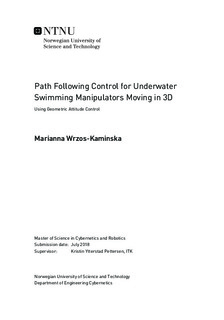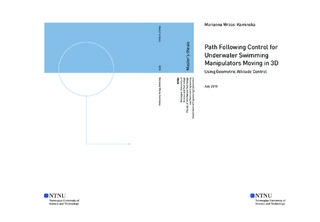| dc.contributor.advisor | Pettersen, Kristin Ytterstad | |
| dc.contributor.author | Wrzos-Kaminska, Marianna | |
| dc.date.accessioned | 2018-09-17T14:01:29Z | |
| dc.date.available | 2018-09-17T14:01:29Z | |
| dc.date.created | 2018-07-16 | |
| dc.date.issued | 2018 | |
| dc.identifier | ntnudaim:18658 | |
| dc.identifier.uri | http://hdl.handle.net/11250/2563041 | |
| dc.description.abstract | The underwater swimming manipulator (USM) is a snake robot equipped with thrusters for faster propulsion or hovering. The entire articulated body of the USM can be used as a floating manipulator arm, and its slender build allows it to access confined spaces in order to perform inspection and maintenance of underwater structures. In order to extend operation time and energy-efficient methods of transport between sites are needed.
In the work presented in this thesis, a path-following method for USMs moving in 3D using the joints of the USM for direction control by means of curving its body is developed. This aims to conserve energy by reducing the use of thrusters.
A control law for tracking a time-varying pointing direction using only two control inputs is developed as a first step. The control law is proven to give asymptotic tracking of the reference, and has no fixed singularities.
Based on this control law, a method for pointing the head of the USM in the desired direction of travel by using its joints is proposed. The method is combined with a guidance law to create a path-following controller for following straight paths.
Different body curves and the use of thrusters to aid the direction control have been investigated through simulations. The simulations show that the USM does not manage to follow the path when the joints are used as the sole means of controlling its direction. It does however remain sufficiently close to the path to make this a plausible method of travel in open areas. Shapes which keep the front portion of the USM straight while primarily using the back for direction control like the tail of a fish, generally stayed closer to the path.
Simulations also demonstrated that exploiting the presence of multiple longitudinal thrusters to stabilise the pointing direction of the USM removed the oscillations in the horizontal plane, without engaging more thrusters than already used for forward propulsion. | |
| dc.language | eng | |
| dc.publisher | NTNU | |
| dc.subject | Kybernetikk og robotikk, Navigasjon og fartøystyring | |
| dc.title | Path Following Control for Underwater Swimming Manipulators Moving in 3D - Using Geometric Attitude Control | |
| dc.type | Master thesis | |

